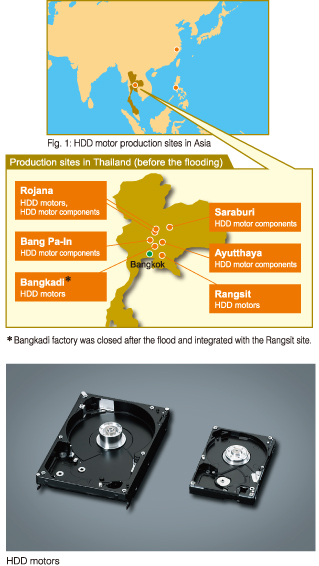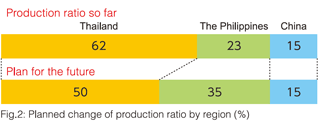Special Feature 2012 - Nidec's Risk Management and Strategy
1. Diversification of Production Risks
Early Recovery of Motor Supplies from Water Inundation due to Flooding in Thailand

The large-scale flooding disaster that occurred in Thailand in October 2011 illuminated clearly the fact that a decentralization of production bases minimizes damage and enables an early recovery. Nidec Group has a global market share of approximately 80% in the area of Hard Disk Drive motors (HDD motors) that are mainly used in PCs and servers, and 62% of Nidec production was concentrated in Thailand.
A possible stop of HDD production due to a halt in Nidec operations halt to operations at Nidec has a huge impact on customers, supplies, and end users. In order to avoid risks connected with production bases, Nidec Group's production of its core product, HDD motors, is spread out over three countries - Thailand, China, and Philippines - and the seven production bases in Thailand are located in three provinces (Fig. 1).
As six of the production bases in Thailand stopped operations due to flooding, we had to assume the worst for some time; however, in addition to the early recovery of the affected production bases in Thailand, the fact that we were able to utilize alternative sourcing from China and the Philippines secured continued product supply to our customers.
Our approach of manufacturing the same products at multiple production bases successfully minimized the damage that ensues due to such risks, which can arise anytime, anywhere.
Nidec Has Achieved Smooth Alternative Production by Diversifying Its Production Bases Worldwide
With the large-scale flooding in Thailand, points that need to be addressed also came to light. More than 60% of the customers of our HDD motors are concentrated in Thailand, and it is undeniable that the production ratio of Nidec Group, which had been producing and supplying products in the region close to the customers, had become too high. Therefore, Nidec is working towards reducing the Thai production ratio and increasing the ratio of China and the Philippines together to approximately 50% (Fig. 2).
With production lines for all models, even if just for small quantities, installed at the production bases in each country, making in an emergency only a strengthening of equipment necessary, the relationship of trust and confidence established with customers will not be lost and product supply to end users all over the world is secured.
The Great East Japan Earthquake and the flooding in Thailand showed a large after-the-fact gap between companies that diversify risks and companies that do not follow such an approach. Both disasters made us again aware of the fact that a simple pursuance of productivity increase is not enough; sufficient measures for risk management also need to be implemented.

In extraordinary circumstances, it is critical to find ways to fulfill supply responsibilities while supplementing capability, and the standardization of products, which simplifies the international diversification of production bases and alternative production, is an indispensable step towards this goal.

